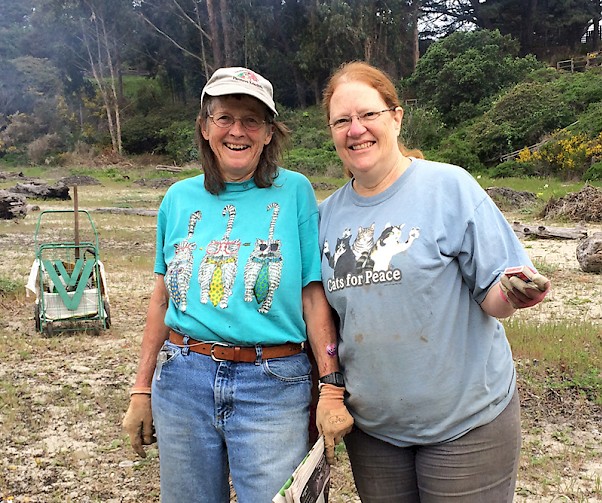News
Interview with Betty, Lenny- 2020 Matt Coleman Award Winners
June 15, 2020
Three months ago, four local nonprofits – the Mendocino Land Trust, MendoParks, Mendocino Coast Audubon Society and the Dorothy King Young Chapter of the California Native Plant Society – watched the early spread of COVID-19 and reluctantly canceled this year’s Environmental Partners Potluck.
At the event, three Land Trust volunteers – Lenny Noack, Betty Stechmeyer and Tom Wodetzki – were to be honored as winners of the Matt Coleman Environmentalist of the Year award. Lenny and Betty have long led the volunteer effort to transform the Land Trust’s preserve at Hare Creek just south of Fort Bragg. Tom has done the same at Navarro Point preserve south of Albion.
The hope was to hold a scaled-down ceremony at a later date, but shelter-in-place rules got in the way. Our winners have waited long enough. Today, we officially honor Lenny, Betty and Tom for their years of service to the local environment and the Mendocino Land Trust. Each agreed to share thoughts about volunteering. We hope you enjoy their stories and join us in thanking them for their dedication.

How long have you been stewarding at Hare Creek? How did you first get involved?
Lenny: I’ve been with Hare Creek from the very beginning (2009). For about a year prior to that, I was helping with mailings for the Land Trust.
Betty: My first involvement at Hare Creek was providing a matching donation in 2008 toward the purchase of the property. Soon after, I spent a day with Louisa Morris of the Land Trust flagging the new trail. Louisa charged ahead, machete in hand, finding areas that would support trail construction. Flag here, she instructed. I planted the flags and did my best to not fall down the hill. Matt Coleman was the first steward. Lenny and I took over leading the volunteers after Matt’s death in 2011.
Can you describe a typical workday at the preserve?
Lenny: The volunteer workdays are mostly spent weeding, weeding, and more weeding of the non-native invasives: Scotch broom, ivy, Himalayan blackberry, thistle. Some folks work quietly alone on a chosen patch, others work in pairs or a small group. We usually only see each other on these once-a-month days, so it’s nice to catch up, and then to stand back after a couple hours and see how much progress we’ve made.
Betty: Workdays vary as much as volunteers do. Matt would assemble us all at the parking lot, talk about the goals, pack up tools and march to the trail. Back then there was heavy work, particularly removal of Scotch broom and old-growth Himalaya vines. Today the volunteers often know what they want to attack and how much time they can afford. If there are new volunteers, they are brought up to speed by old-timers or Lenny or me, given appropriate tools, and set loose to learn.
Before and after: What changes have you seen since you first began working at Hare Creek?
Lenny: When the Land Trust first acquired the property, it was overgrown and the only passage was a few deer trails. Since then, we have removed mini-forests of Scotch broom, pushed back on the blackberry, almost eliminated ice plant covering the beach, and made headway against the ivy. Not only is there now a trail down to the beach, but it is well used!
Betty: The upper hillside was chest-high weeds and steep terrain. The lower trail from the highway was also chest-high growth. Today, entering at the trailhead, there is a beautiful split-rail fence that guides visitors to stairs leading down a trail with a beautiful view of Hare Creek Bridge and the Gordon McBride bench. Visitors follow a broad, sunny trail to the beach – now covered with native plants, not ice plant.
What is the toughest part about working there? Most satisfying or enjoyable part?
Lenny: The hardest thing, for me, is the distance from the parking lot to the trail, and especially back again (uphill). My legs no longer work so well, and now my feet would prefer it if I wouldn’t walk on them. Cranky body aside, it’s good exercise, and nice to work outdoors with like-minded folks. It feels good to contribute to the Earth and to my home area. It’s fulfilling to watch, and be part of, the slow, steady, significant progress being made to this patch of land.
Betty: Toughest? Like life, not having enough time and/or energy to do everything. Enjoyable? Working with volunteers who get so excited that they bring friends to join the fun.
Is there anything in your childhood or background that led you to dedicate yourself to this kind of outdoor work?
Lenny: Though I grew up in Stockton, I’ve always been a back-to-the-land kind of person. I escaped to the horse stables as soon as my mom would let me (age 13), eventually getting my own horse, spending summers working the Slash-N cattle ranch, also a goat dairy, and then the race track. Country is in my genes, and jeans are almost all I wear.
Betty: Nope, though I was privileged enough to enjoy family camping, spring birding and walking to a lake during the summer.
Do you have advice for people considering volunteer work like this?
Lenny: It’s so satisfying to be part of this restorative work, connecting with Mother Earth and with others on a similar path. If someone can contribute one day, it helps, and it feeds the soul. If someone can and become a monthly volunteer (or almost monthly), oh my! That would be fabulous. It’s truly rewarding to be a part of this shining gem called Hare Creek.
Betty: Come out at 10 a.m. on the second Saturday of each month. Talk to other volunteers, find your comfort zone and try a little work. My adventure with Hare Creek began by recognizing an opportunity and following others that came along. Seize opportunities, and see where they might lead.